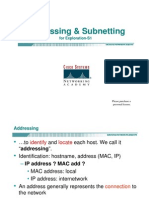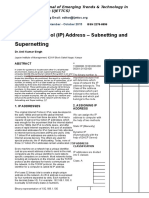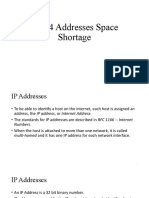0% found this document useful (0 votes)
24 views35 pagesLecture 4 - IP Addressing
The document provides an overview of IP addressing, detailing the functions of IP addresses, the structure of IPv4 and IPv6 addresses, and the classification of IP address types. It explains concepts such as subnet masks, network and broadcast addresses, and the differences between public and private IP addresses. Additionally, it discusses the transition from IPv4 to IPv6 and the coexistence of both addressing schemes.
Uploaded by
Mohammed AlkhatibCopyright
© © All Rights Reserved
We take content rights seriously. If you suspect this is your content, claim it here.
Available Formats
Download as PPTX, PDF, TXT or read online on Scribd
0% found this document useful (0 votes)
24 views35 pagesLecture 4 - IP Addressing
The document provides an overview of IP addressing, detailing the functions of IP addresses, the structure of IPv4 and IPv6 addresses, and the classification of IP address types. It explains concepts such as subnet masks, network and broadcast addresses, and the differences between public and private IP addresses. Additionally, it discusses the transition from IPv4 to IPv6 and the coexistence of both addressing schemes.
Uploaded by
Mohammed AlkhatibCopyright
© © All Rights Reserved
We take content rights seriously. If you suspect this is your content, claim it here.
Available Formats
Download as PPTX, PDF, TXT or read online on Scribd
/ 35





























































































